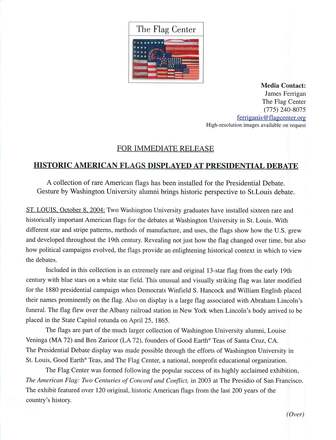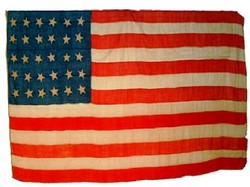

Obverse - edit
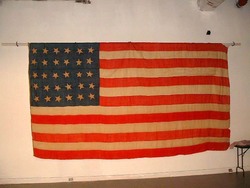
Obverse - edit 2
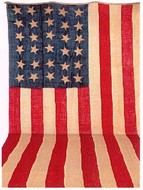
Reverse - edit
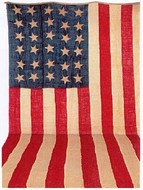
Reverse - edit 1
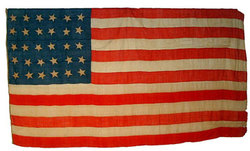
Obverse

Obverse - 2
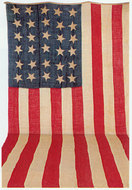
Reverse - Catalog Scan

Reverse - 2
U.S. 30 Star Ensign, Naval or Maritime, 1848-1851.
Sub-collection: Mastai - Early American Flags30-star U.S. Flag commemorating Wisconsin Statehood, May 28, 1848.
This 30-star United States flag came into official existence on July 4th, 1848 when, in accordance with the Flag Act of 1818, Wisconsin's admission to the Union was recognized in the country's flag. The 30-star U.S. flag, however, would have a relatively short official existence. As a consequence of the discovery of gold in California, a rush of emigrants ventured to that territory between 1848 and 1850. So many settled in California that the territory was soon able to apply for and attain statehood, which occurred on September 9th, 1850. Accordingly the U.S. flag grew to 31 stars, effective on July 4th, 1851.
The adoption of the 31-star U.S. flag did not force the obsolescence of the 30-star flag, as many who had owned the 30-star saw little need to acquire another. Indeed, an English observer looking out over New York Harbor in 1857 commented: The majority of the ships had the stars arranged in five horizontal rows of six stars each, making thirty stars in all, despite thirty-one being the proper number of stars on the date. For ship owners, frugality took precedence over propriety.
The 30 stars in the canton of this large U.S. flag are displayed in five horizontal rows, of six stars each. Wool bunting field and canton with cotton stars, all hand sewn. Size: 108" on the hoist by 202" on the fly (8' by 17')
Exhibition History:
Moraga Room Flag Label - Jan 2003
30-Star United States Flag
(ZFC0608)
Special Memorial Day Display
Suspended from ceiling of Moraga Room.
Presidio of San Francisco's Officers Club
Memorial Day 2003
Baltimore Star Spangled Banner Flag House 3/2004
(ZFC0608)
30-Star United States Flag
American Maritime Flags of the 19th Century
Presidential Debate
Washington University at St. Louis
October 2004
(ZFC0608)
Provenance:
• Acquired by Mr. & Mrs. Boleslaw & Marie-Louise d'Otrange Mastai, New York City, and Amagansett, NY, The Mastai Collection, until 2002.
• Sold via Sotheby's Auction in New York City to the Zaricor Flag Collection, 2002.
ZFC Significant Flag
Sources:
Madaus, Howard M.- Whitney Smith, The American Flag: Two Centuries of Concord and Conflict, VZ Publications, Santa Cruz, 2006.
Preble, George Henry, The History of the Flag of the United States of America, Boston, Houghton, Mifflin & Co. 1894.
30 Star Flag - (1848-1851) (U.S.), Flags of the World, 14 November 2011, from: http://www.crwflags.com/fotw/flags/us-1848.html
Mastai, Boleslaw and Marie-Louise D'Otrange, The Stars and The Stripes: The American Flag as Art and as History from the Birth of the republic to the Present, Knopf, New York, 1973.
Image Credits:
Zaricor Flag Collection
Hoist & Fly | |
|---|---|
| Width of Hoist | 108 |
| Length of Fly | 202 |
Union/Canton | |
|---|---|
| Width of Union/Canton | 60 |
| Length of Union/Canton | 66 |
Stars | |
|---|---|
| Size of Stars | 7 |
Stripes | |
|---|---|
| Size of Hoist | 1.25 |
Frame | |
|---|---|
| Is it framed? | no |
Stars | |
|---|---|
| Number of Stars | 30 |
| How are the stars embeded? | Sewn |
| Are there stars on obverse? | yes |
| Are there stars on reverse? | yes |
Stripes | |
|---|---|
| Number of Stripes | 13 |
| Color of Top Stripe | Red |
| Color of Bottom Stripe | Red |
| Has a Blood Stripe? | no |
Nationality | |
|---|---|
| Nation Represented | United States |
Fabric | |
|---|---|
| Fabric | Wool |
| Comments on Fabric | Bunting |
Stitching | |
|---|---|
| Stitching | Machine |
Weave | |
|---|---|
| Type of Weave | Plain |
Attachment | |
|---|---|
| Comments on Method of Attachmen | Through header |
| Method of Attachment | Loops |
Applica | |
|---|---|
| Applique Sides | Single Faced = Mirror Image Reverse |
Condition | |
|---|---|
| Condition | Fair |
| Damage | used |
| Displayable | yes |
Date | |
|---|---|
| Date | 1848 |
Exhibits | |
|---|---|
| Exhibition Copy | Moraga Room Flag Label - Jan 2003 30-Star United States Flag (ZFC0608) Date: 1848-1850 Media: Wool bunting and cotton stars; all hand stitched Comment: 30-star American National Flag commemorating Wisconsin Statehood, May 28, 1848. Provenance: Acquired by the Zaricor Flag Collection (ZFC0608) in 2002 from the Mastai Flag Collection of New York City through auction at Sotheby's. Special Memorial Day Display Suspended from ceiling of Moraga Room. Presidio of San Francisco's Officers Club Memorial Day 2003 30-Star United States Flag Date: 1848 1851 (official on 4 July 1848 subsequent to Wisconsin's admission to statehood on 29 May 1848) Comment: The 30 stars in the canton of this large U.S. flag are displayed in five horizontal rows, of six stars each. It probably was a ship flag. (ZFC0608) Baltimore Star Spangled Banner Flag House 3/2004 (ZFC0608) 30-Star United States Flag Date: 1848-1850+ (Wisconsin was admitted to statehood on May 29, 1848) Media: Wool bunting field and canton with cotton stars, all hand sewn. Size: 108" on the hoist by 202" on the fly (8' by 17') Comment: This 30-star United States flag came into official existence on July 4th, 1848 when, in accordance with the Flag Act of 1818, Wisconsin's admission to the Union was recognized in the country's flag. The 30-star U.S. flag, however, would have a relatively short official existence. As a consequence of the discovery of gold in California, a rush of emigrants ventured to that territory between 1848 and 1850. So many settled in California that the territory was soon able to apply for and attain statehood, which occurred on September 9th, 1850. Accordingly the U.S. flag grew to 31 stars, effective on July 4th, 1851. The adoption of the 31-star U.S. flag did not force the obsolescence of the 30-star flag, as many who had owned the 30-star saw little need to acquire another. Indeed, an English observer looking out over New York Harbor in 1857 commented: The majority of the ships had the stars arranged in five horizontal rows of six stars each, making thirty stars in all, despite thirty-one being the proper number of stars on the date. For ship owners, frugality took precedence over propriety. Provenance: Acquired by the Zaricor Flag Collection in 2002 from the Mastai Collection through auction at Sotheby's of New York, New York. American Maritime Flags of the 19th Century Ships and coastal installations (both governmental and private) require flags that can be identified from great distances. Recognition was achieved during the nineteenth century by providing these vessels and facilities with flags that were especially large. Exhibited here are several American flags related to such vessels or facilities from the period 1818 to 1893. They are all large bunting flags. Generally speaking, a large flag is one that is too unwieldy to be carried by one person if the flag is attached to a staff meant to be carried by a single individual. Until 1854 in the British Army, and until 1895 in the American Army, military colors carried by units on foot were made of silk and measured no more than 6 feet on the staff by 6 feet 6 inches on the fly. An individual on a staff deemed those dimensions, which result essentially in a flag with an area encompassing slightly more than four square yards of cloth, the maximum size for transport. However, most of the flags in this exhibit exceed those parameters. Due to their size, large flags such as these are difficult to display and are seldom sought by collectors. Museums often relegate them to perpetual storage. This exhibit is unusual, therefore, in that it displays so many of these massive flags in one place. The Veninga-Zaricor family, Good Earth Teas of Santa Cruz, CA, The Flag Center Presidio of San Francisco, CA, and the Star-Spangled Banner Flag House of Baltimore, MD, sponsors this exhibit. Presidential Debate Washington University at St. Louis October 2004 (ZFC0608) 30-Star United States Flag Wisconsin Admitted (18481851) The 30-star United States flag came into official existence on July 4, 1848, when Wisconsin's admission to the Union as its thirtieth state was officially recognized in the country's flag. The 30-star U.S. flag, however, would have a relatively short official existence. As a consequence of the discovery of gold in California, a rush of emigrants ventured to that territory between 1848 and 1850. So many settled in California that the territory was soon able to apply for and attain statehood. The adoption of the 31-star U.S. flag did not force the obsolescence of the 30-star flag, as many who had acquired the 30-star flag saw little need to acquire another. Indeed, an English observer looking out over New York Harbor in 1857 commented that the majority of the ships had the stars arranged in five horizontal rows of six stars each, making thirty stars in all, despite thirty-one being the proper number on that date. For ship owners, frugality took precedence over propriety. Acquired from Sotheby's Auction in New York City on October 10, 2002. Mastai Lot No. 58. 9 pieces. The exhibition text was written by Howard Michael Madaus, Exhibition Director of the ZFC's Flag Center, utilizing Zaricor Flag Collection archives. |
| Exhibition Images | |








